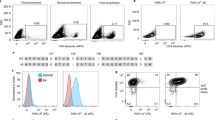Abstract
ALTHOUGH many peptides are generated during the intracellular processing of protein antigens, only a few are selected for recognition by the immune system1–5. The immunodominant epitope of hen egg white lysozyme (HEL) for H–2k mice is contained in a tryptic fragment of amino-acid residues 46–61 (refs 6,7). The core of this T-cell epitope, from amino acids 52 to 61 (DYGILQINSR), contains those residues required for binding to the class II molecule I–Ak (ref. 7). Most of the naturally processed fragments recovered from I–Ak-bearing antigen-presenting cells (APCs) cultured with HEL contained this 52–61 core sequence, presented as a nested set of peptides with extensions at both the amino and carboxyl termini8. We now compare the handling by APCs of peptides containing HEL 52–61 to establish whether there is an advantage for the APC in selecting extended peptides: different complexes between peptides and major histocompatibility complex (MHC) molecules varied greatly in the amount of time associated with the APC, and in their immunogenic strength. This difference in persistence is one of the factors contributing to the selection and immune recognition of peptide–MHC complexes by T cells.
This is a preview of subscription content, access via your institution
Access options
Subscribe to this journal
Receive 51 print issues and online access
$199.00 per year
only $3.90 per issue
Buy this article
- Purchase on Springer Link
- Instant access to full article PDF
Prices may be subject to local taxes which are calculated during checkout
Similar content being viewed by others
References
Rosenthal, A. S., Barcinski, M. A. & Blake, J. T. Nature 267, 156–159 (1977).
Katz, M. E., Maizels, R. M., Wicker, L., Miller, A. & Sercarz, E. E. Eur. J. Immun. 12, 535–540 (1982).
Babbitt, B. P., Allen, P. M., Matsueda, G., Haber, E. & Unanue, E. R. Nature 317, 359–361 (1985).
Buus, S., Sette, A., Colon, S. M., Miles, C. & Grey, H. M. Science 235, 1353–1358 (1987).
Adorini, L., Appella, E., Doria, G. & Nagy, Z. A. J. exp. Med. 168, 2091–2104 (1988).
Allen, P. M., Strydom, D. J. & Unanue, E. R. Proc. natn. Acad. Sci. U.S.A. 81, 2489–2493 (1984).
Allen, P. M., Matsueda, G. R., Evans, R. J., Dunbar, J. B. jun., Marshall, G. & Unanue, E. R. Nature 327, 713–715 (1987).
Nelson, C. A., Roof, R. W., McCourt, D. W. & Unanue, E. R. Proc. natn. Acad. Sci. U.S.A. 89, 7380–7383 (1992).
Haughton, G., Arnold, L. W., Bishop, G. A. & Mercolino, T. J. Immun. Rev. 93, 35–51 (1986).
Glimcher, L. H. et al. J. Immun. 130, 2287–2294 (1983).
Wade, W. F. et al. Proc. natn. Acad. Sci. U.S.A. 86, 6297–6301 (1989).
Lanzavecchia, A., Reid, P. A. & Watts, C. Nature 357, 249–252 (1992).
Pedrazzini, T., Sette, A., Albertson, M. & Grey, H. M. J. Immun. 146, 3496–3501 (1991).
Adorini, L., Appella, E., Doria, G., Cardinaux, F. & Nagy, Z. A. Nature 342, 800–804 (1989).
Nelson, C. A., Petzold, S. J. & Unanue, E. R. Proc. natn. Acad. Sci. U.S.A. 90, 1227–1231 (1993).
Dornmair, K., Rothenhausler, B. & McConnell, H. M. Cold Spring Harb. Symp. quant. Biol. 54(1), 409–416 (1989).
Germain, R. N. & Hendrix, L. R. Nature 353, 134–139 (1991).
Sadegh-Nasseri, S. & Germain, R. N. Nature 353, 167–170 (1991).
Germain, R. N. & Rinker, A. G. Nature 363, 725–728 (1993).
Stern, L. J. & Wiley, D. C. Cell 68, 465–477 (1992).
Riberdy, J. M., Newcomb, J. R., Surman, M. J., Barbosa, J. A. & Creswell, P. Nature 360, 474–477 (1992).
Pierres, M., Devaux, C., Dosseto, M. & Marcheto, S. Immunogenetics 14, 481–495 (1981).
Oi, V. T., Jones, P. P., Goding, J. W. & Herzenberg, L. A. Curr. Topics Microbiol. Immun. 81, 115–129 (1978).
Harding, C. V., Roof, R. W. & Unanue, E. R. Proc. natn. Acad. Sci. U.S.A. 86, 4230–4234 (1989).
Author information
Authors and Affiliations
Rights and permissions
About this article
Cite this article
Nelson, C., Petzold, S. & Unanue, E. Peptides determine the lifespan of MHC class II molecules in the antigen-presenting cell. Nature 371, 250–252 (1994). https://doi.org/10.1038/371250a0
Received:
Accepted:
Issue Date:
DOI: https://doi.org/10.1038/371250a0
This article is cited by
-
Vaccination of fiber-modified adenovirus-transfected dendritic cells to express HER-2/neu stimulates efficient HER-2/neu-specific humoral and CTL responses and reduces breast carcinogenesis in transgenic mice
Cancer Gene Therapy (2008)
-
Subversion of innate and adaptive immune responses by Toxoplasma Gondii
Parasitology Research (2007)
-
The structure of an intermediate in class II MHC maturation: CLIP bound to HLA-DR3
Nature (1995)
-
Antigen presentation mediated by recycling of surface HLA-DR molecules
Nature (1995)
-
Mediation by HLA-DM of dissociation of peptides from HLA-DR
Nature (1995)
Comments
By submitting a comment you agree to abide by our Terms and Community Guidelines. If you find something abusive or that does not comply with our terms or guidelines please flag it as inappropriate.



